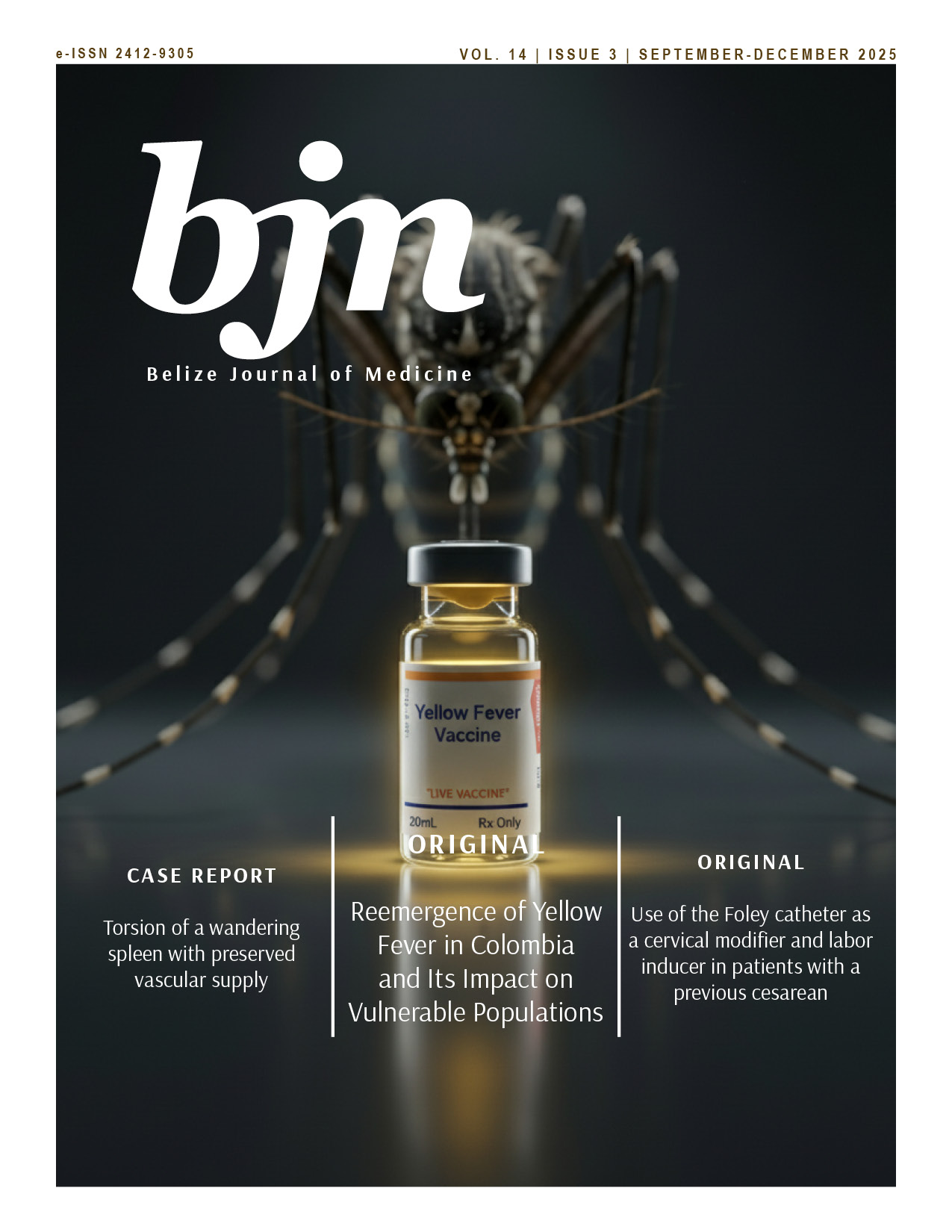Re-emergence of Yellow Fever in Colombia, Geographic Expansion and Impact on Vulnerable Populations
DOI:
https://doi.org/10.61997/bjm.v14i3.483Keywords:
Colombia, Disease outbreaks, Epidemiological monitoring, Vector-borne diseases, Yellow fever, VaccinationAbstract
Introduction: Yellow fever is a vector-borne viral disease endemic in the Americas and Africa, characterized by high lethality and lack of specific treatment. Despite the availability of an effective vaccine, outbreaks persist, even in non-endemic areas. Objective: To analyze the epidemiological evolution of yellow fever in Colombia between 2007 and 2025, focusing on the displacement of cases into non-endemic areas. Methods: A retrospective descriptive study was conducted using secondary data from the National Public Health Surveillance System and reports from the National Institute of Health. The study population comprised 87 confirmed yellow fever cases reported in the country during this period. Sociodemographic, geographic, clinical, and vaccination-related variables were analyzed. Results: Most cases occurred in men (86.2%), aged 20-24 years (23%), residing in rural areas (67.8%), and affiliated with the subsidized healthcare system (73.6%). A significant increase in cases was observed in 2024 (23) and 2025 (38), primarily in Tolima (54%), Meta (12.6%), and Caquetá (8.1%), all non-endemic regions. The case fatality rate was 53%, higher among those seeking care after the tenth day of symptom onset. Vaccination coverage was low, with only 9.52% and 10.5% of cases having a recorded vaccination history in 2024 and 2025, respectively. Conclusion: The findings suggest that social factors such as healthcare affiliation, rural residence, and low vaccination coverage contribute to the displacement of yellow fever cases to non-endemic areas. Strengthening surveillance, vaccination records, and preventive strategies in at-risk areas is urgently required to control the spread of the disease.
Downloads
References
Ministerio de Salud y Protección Social. Fiebre amarilla [Internet]. Bogotá: Ministerio de Salud; [citado 11 mayo 2025]. Disponible en: https://www.minsalud.gov.co/salud/publica/PET/Paginas/fiebre-amarilla.aspx
Simon LV, Hashmi MF, Torp KD. Yellow fever. In: StatPearls [Internet]. Treasure Island (FL): StatPearls Publishing; 2023. Available from: https://www.ncbi.nlm.nih.gov/books/NBK470425/
Organización Mundial de la Salud. Fiebre amarilla [Internet]. Ginebra: OMS; 2023 [citado 7 mayo 2025]. Disponible en: https://www.who.int/es/news-room/fact-sheets/detail/yellow-fever
Centers for Disease Control and Prevention. National Center for Infectious Diseases [Internet]. Atlanta: CDC; [citado 10 mayo 2025]. Disponible en: http://www.cdc.gov/ncidod/
Valente-Acosta B, García-Acosta J. Fiebre amarilla: revisión concisa ante el actual escenario epidemiológico. Med Int Mex. 2017; 33(5):648–54. doi: 10.24245/mim.v33i5.1560 DOI: https://doi.org/10.24245/mim.v33i5.1560
Barnett ED. Yellow fever: Epidemiology and prevention. Clin Infect Dis. 2007; 44(6):850–6. doi: 10.1086/511869 DOI: https://doi.org/10.1086/511869
Garske T, Van Kerkhove MD, Yactayo S, Ronveaux O, Lewis RF, Staples JE, et al. Yellow fever in Africa: estimating the burden of disease and impact of mass vaccination from outbreak and serological data. PLoS Med. 2014; 11(5):e1001638. doi: 10.1371/journal.pmed.1001638 DOI: https://doi.org/10.1371/journal.pmed.1001638
Organización Panamericana de la Salud. Alerta de fiebre amarilla en la región de las Américas [Internet]. Washington, D.C.: OPS; mayo 2025 [citado 3 junio 2025]. Disponible en: https://www.paho.org/es/documentos/alerta-epidemiologica-fiebre-amarilla-region-americas-31-mayo-2025
Hernández-Galvis J, Pizarro AB, Cuestas JA, Castañeda-Cardona C, Rosselli D. La fiebre amarilla en Colombia: de calamidad pública a enfermedad desatendida. Acta Med Peru. 2018; 35(1):55–9. Disponible en: http://www.scielo.org.pe/scielo.php?script=sci_arttext&pid=S1728-59172018000100009 DOI: https://doi.org/10.35663/amp.2018.351.517
Agudelo Chivata NJ. Informe de evento: fiebre amarilla [Internet]. Bogotá: Instituto Nacional de Salud; 2024 [citado 18 mayo 2025]. Disponible en: https://www.ins.gov.co/buscador-eventos/Paginas/Vista-Boletin-Epidemilogico.aspx
Agudelo Chivata NJ. Infografía de evento: fiebre amarilla [Internet]. Bogotá: Instituto Nacional de Salud; 2025 [citado 18 mayo 2025]. Disponible en: https://www.ins.gov.co/buscador-eventos/Paginas/Vista-Boletin-Epidemilogico.aspx
Gushulak BD, MacPherson DW. The basic principles of migration health: population mobility and gaps in disease prevalence. Emerg Themes Epidemiol. 2006; 3(3):1–11. doi: 10.1186/1742-7622-3-3 DOI: https://doi.org/10.1186/1742-7622-3-3
Vasconcelos PF. Yellow fever in Brazil: thoughts and hypotheses on the emergence in previously free areas. Rev Saude Publica. 2010; 44(6):1144–9. doi: 10.1590/s0034-89102010005000046 DOI: https://doi.org/10.1590/S0034-89102010005000046
La Jornada. Petro anuncia emergencia económica por brote de fiebre amarilla en Tolima [Internet]. 20 mayo 2025 [citado 20 mayo 2025]. Disponible en: https://www.lajornada.co/petro-anuncia-emergencia-economica-por-brote-de-fiebre-amarilla-en-tolima
Kaul RB, Evans MV, Murdock CC, Drake JM. Spatio-temporal spillover risk of yellow fever in Brazil. Parasit Vectors. 2018; 11(1):488. doi: 10.1186/s13071-018-3063-6 DOI: https://doi.org/10.1186/s13071-018-3063-6
Burkett-Cadena ND, Vittor AY. Deforestation and vector-borne disease: forest conversion favors important mosquito vectors of human pathogens. Basic Appl Ecol. 2017; 26:101–10. doi: 10.1016/j.baae.2017.09.012 DOI: https://doi.org/10.1016/j.baae.2017.09.012
Global Forest Watch. Colombia deforestation rates & statistics [Internet]. Washington, D.C.: World Resources Institute; [citado 24 mayo 2025]. Disponible en: https://www.globalforestwatch.org/dashboards/country/COL
Zimmermann ML. Colombia: industria petrolera pone en peligro el último relicto de bosque de niebla del Tolima [Internet]. Mongabay; 21 agosto 2018 [citado 24 mayo 2025]. Disponible en: https://es.mongabay.com/2018/08/bosque-de-niebla-peligro-petroleo-tolima-colombia
Le Hir A, Durand GA, Boucraut J, Garnier A, Mura M, Diamantis S, et al. Yellow fever vaccine-associated neurologic and viscerotropic disease: a 10-year case series of the French National Reference Center for Arboviruses with clinical and immunological insights. J Travel Med. 2024; 31(2): taad160. doi: 10.1093/jtm/taad160 DOI: https://doi.org/10.1093/jtm/taad160
Staples JE, O’Laughlin K. Yellow fever. In: CDC Yellow Book 2024: health information for international travel [Internet]. Atlanta: Centers for Disease Control and Prevention; 23 abril 2025 [citado 20 mayo 2025]. Disponible en: https://www.cdc.gov/yellow-book/hcp/travel-associated-infections-diseases/yellow-fever.html
Pigram T. Looping: how poverty and vector-borne diseases fuel each other. BugBitten [Internet]. 15 diciembre 2023 [citado 10 mayo 2025]. Disponible en: https://blogs.biomedcentral.com/bugbitten/2023/12/15/looping-how-poverty-and-vector-borne-diseases-fuel-each-other
Ministerio de Salud y Protección Social. Fiebre amarilla [Internet]. Bogotá: Ministerio de Salud; [citado 11 mayo 2025]. Disponible en: https://www.minsalud.gov.co/salud/publica/PET/Paginas/fiebre-amarilla.aspx
Kakoni PM, Bazitama YM, Nepomuceno JR, Pukuta-Simbu E, Mawika FK, Mujinga GK, et al. Leptospirosis as a cause of fever associated with jaundice in the Democratic Republic of Congo. PLoS Negl Trop Dis. 2021; 15(8):e0009670. doi: 10.1371/journal.pntd.0009670 DOI: https://doi.org/10.1371/journal.pntd.0009670
Downloads
Published
How to Cite
Issue
Section
License
Copyright (c) 2025 Luisa Suarez-Ordonez, Santiago Romero-Troya, Juan Felipe Toscano, Mario Javier Olivera, Francisco Palencia-Sánchez

This work is licensed under a Creative Commons Attribution-NonCommercial 4.0 International License.
BJM protects Copyright at all times. However, it gives up part of the rights by displaying a Creative Commons License 4.0 (cc-by-nc), which allows the use of the work to share (copy and redistribute the material in any support or format) and adapt (transform and built from the material) as long as exclusive mention of the publication in the journal as the primary source is made. Under no circumstances, the work can be commercialized.













